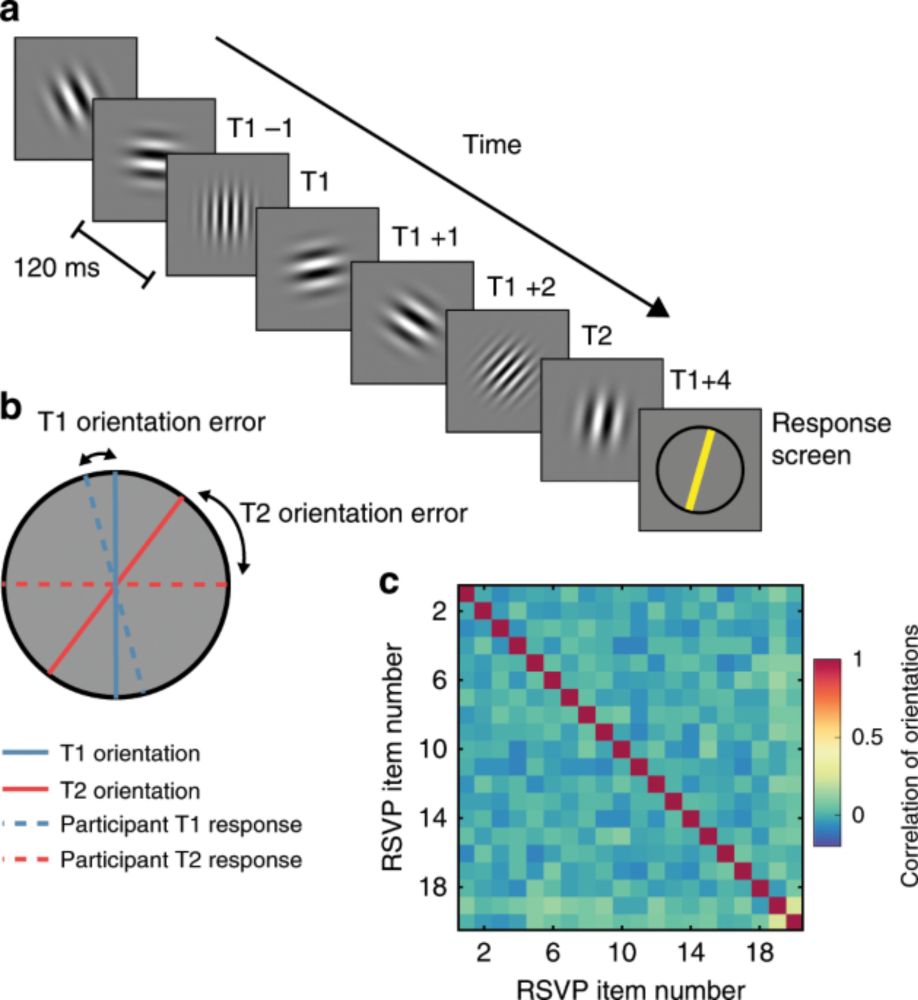
Bugay Yıldırım
@bugayyildirim.bsky.social
PhD candidate | serial dependence in vision, ensemble perception, attention, memory | R enthusiast | @rug.nl alum. | cablab.ku.edu.tr
About “T2|T1” and “T3|T1” errors: since this was an attentional blink design, we only included trials where T1 was accurately reported (<22.5°). This ensures our “uncertainty” manipulation works properly.
October 30, 2025 at 4:03 PM
About “T2|T1” and “T3|T1” errors: since this was an attentional blink design, we only included trials where T1 was accurately reported (<22.5°). This ensures our “uncertainty” manipulation works properly.
In Fig. 5, the purple line shows trials where T1 is clockwise to T3. Left pane: T2 is also clockwise - both push T3 the same way = stronger repulsion from T2. Right pane: T2 is counterclockwise - T1 and T2 oppose = weaker repulsion from T2.
October 30, 2025 at 4:03 PM
In Fig. 5, the purple line shows trials where T1 is clockwise to T3. Left pane: T2 is also clockwise - both push T3 the same way = stronger repulsion from T2. Right pane: T2 is counterclockwise - T1 and T2 oppose = weaker repulsion from T2.
In Fig. 4, labels refer to T1-induced bias. Different-colored lines show how T1-induced repulsion is further amplified when T3 also repels T2 in the same direction, and vice versa. The same logic applies in Fig. 5 too but now labels refer to T2-induced bias.
October 30, 2025 at 4:03 PM
In Fig. 4, labels refer to T1-induced bias. Different-colored lines show how T1-induced repulsion is further amplified when T3 also repels T2 in the same direction, and vice versa. The same logic applies in Fig. 5 too but now labels refer to T2-induced bias.
Thanks a lot! I can see how Figures 4 & 5 can be confusing. I think computing bias instead of errors is a great idea—I’ll definitely try and implement this.
October 30, 2025 at 4:03 PM
Thanks a lot! I can see how Figures 4 & 5 can be confusing. I think computing bias instead of errors is a great idea—I’ll definitely try and implement this.
Yes, it involved human participants (not patients though), but in fact it was not aimed at improving memory. Rather we investigated how visual attention and perception work.
June 18, 2025 at 6:16 PM
Yes, it involved human participants (not patients though), but in fact it was not aimed at improving memory. Rather we investigated how visual attention and perception work.
That's an interesting question. You’re likely familiar with no-report paradigms investigating serial dependence, which might be relevant here. In our study, we collected T1 responses to elicit the attentional blink but haven’t randomized response order or used a no-report paradigm in our lab yet.
December 5, 2024 at 12:55 PM
That's an interesting question. You’re likely familiar with no-report paradigms investigating serial dependence, which might be relevant here. In our study, we collected T1 responses to elicit the attentional blink but haven’t randomized response order or used a no-report paradigm in our lab yet.
I believe this might have been the critical factor in the change of direction. In another study, where we used Gabor patches, we also found attractive biases in AB. link.springer.com/article/10.3...

Temporal integration of target features across and within trials in the attentional blink - Attention, Perception, & Psychophysics
Attentional blink research has typically investigated attentional limitations in multiple target processing. The current study investigated the temporal integration of target features in the attention...
link.springer.com
December 5, 2024 at 12:46 PM
I believe this might have been the critical factor in the change of direction. In another study, where we used Gabor patches, we also found attractive biases in AB. link.springer.com/article/10.3...
Yes, exactly! I think this might have something to do with the fact that they sampled target orientations randomly from uniform. In our study, we sampled one orientation randomly then added/subtracted a certain "delta" to generate two other orientations.
December 5, 2024 at 12:46 PM
Yes, exactly! I think this might have something to do with the fact that they sampled target orientations randomly from uniform. In our study, we sampled one orientation randomly then added/subtracted a certain "delta" to generate two other orientations.
I'm not sure how relevant the following paper is. It is an RSVP design and due to the attentional blink effect at certain inter-target intervals, addressing your question might be challenging. Yet, I think it could still offer some useful insights. www.nature.com/articles/s41...

Neural dynamics of the attentional blink revealed by encoding orientation selectivity during rapid visual presentation - Nature Communications
People often fail to perceive the second of two brief visual targets, a phenomenon known as the attentional blink (AB). Here the authors modelled behaviour and brain activity to show that the AB arise...
www.nature.com
December 5, 2024 at 12:18 PM
I'm not sure how relevant the following paper is. It is an RSVP design and due to the attentional blink effect at certain inter-target intervals, addressing your question might be challenging. Yet, I think it could still offer some useful insights. www.nature.com/articles/s41...
Thank you! Yes, they reported all three on each trial in the presented order. We used color as an additional cue to minimize potential swap errors.
December 5, 2024 at 12:00 PM
Thank you! Yes, they reported all three on each trial in the presented order. We used color as an additional cue to minimize potential swap errors.

